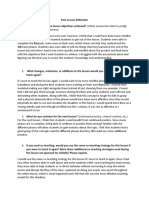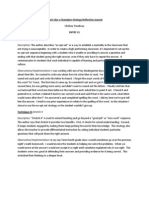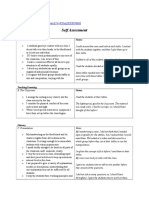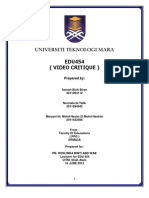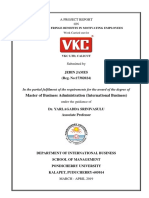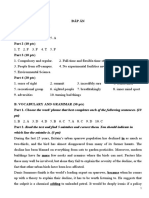EFDT
EFDT
Uploaded by
AlAr-JohnTienzoTimeniaCopyright:
Available Formats
EFDT
EFDT
Uploaded by
AlAr-JohnTienzoTimeniaCopyright
Available Formats
Share this document
Did you find this document useful?
Is this content inappropriate?
Copyright:
Available Formats
EFDT
EFDT
Uploaded by
AlAr-JohnTienzoTimeniaCopyright:
Available Formats
https://math4teaching.
com/explore-firm-up-deepen-transfer-confusion/
When we were just being trained to be teachers of mathematics it was emphasized to us
that in planning our lesson we should think of manipulative activities whose results will
eventually lead to the concepts to be learned. The teacher will make use of the students
results to introduce the new concept through another whole class activity to tie together
the results or through question and answer discussion. This leads to the definition of the
concept by the teacher or to a certain procedure or calculation with the help of the
students, depending on the topic. The teacher then gives exercises so students can hone
their skill or deepen their understanding of the concept. A homework, usually a more
difficult version of the one just done in the class, is given at the end of the lesson. I don’t
remember my supervising teacher requiring me to always give a test at the end of my
lesson. I think I was on my third year of teaching in public school when this ‘bright idea’
of giving a test at the end every lesson was imposed. Failure to do so means you did not
have a good lesson because you do not have an evaluation part! Anyway, let me stop
here as this is not what I want to talk about in this post. I want to talk about the latest
ruling about “Ubidized lesson pans”.
image from art.com
When I first heard about the DepEd’s “Explore-FirmUp-Deepen-Transfer” version
of UbD I remember the framework I followed when I was doing practice teaching at
Bicol University Laboratory High School. The lesson starts with activities, process
results of activities to give birth to the new concept, firm-up and deepen the learning
with additional exercise and activities and then use the homework to assess if students
can transfer their learning to a little bit more complex situation. So I thought EFDT
must not be a bad idea. I have observed as a teacher-trainer that over the years teachers
have succumbed to the temptation of talk-and-talk method of teaching. Reason: there
are too many students, activities are impossible; too many classes to handle, too many
topics to cover. With this scenario I thought EFDT may turn out to be a much better
guide in planning the lesson that the one currently being used: “Motivation-
LessonProper-Practice-Evaluation” because EFDT actually describes what the teachers
need to do at each part of the lesson. But it turned out that EFDT was very different
what I think it is and is being implemented per chapter and not per topic or lesson in the
chapter!
I don’t know if the teachers simply misinterpreted it or this is really how the DepEd
wants it implemented. If this is how UbD is being done in the entire archipelago then we
have a BIG problem.
The chapter is divided into four parts: First part- Explore; Second part- Firm
Up; Third Part – Deepen; Fourth Part – Transfer. There are many unit topics in a
chapter so it means for example that what is being ‘deepened’ is a different topic to what
has been ‘firmed-up” or “explored’! I think this is a mortal sin in teaching.
EFDT is used in all subject areas. The nature of each subject, each discipline, is
different. I don’t know why some people think they can be taught in the same way or to
even think that within a discipline, its topics can be taught in the same way. Or that the
same style of teaching is applicable to all year levels in all kinds of ability. UbD, the real
one, not our version, does not even promote a particular way of teaching but a particular
way of planning. Stges 1 and 2 dictates the teaching that you needed to do.
Activities for Explore part always have to be done in groups and with some
physical movement. A math teacher was complaining to me that her students no longer
have the energy for their mathematics class especially during the “explore’ part because
all subject areas have activities and group work so by the time it’s math period which
happens to be the fourth in the morning, students no longer want to move. The explore
part alone can run for several days. All the while I thought the “explore part” of EFDT
can be done with a mathematical investigation or an open-ended problem.
The prepared lesson plans given during the training consists of activities from
explore part to transfer part and teachers implement them one after another without
much processing and connection. Most activities aren’t connected anyway.
The teachers can modify the activity but they said they don’t have resources
where to get activities.
The teachers cannot modify the first two parts of the UbD plan. The teachers
said they were told not to modify them. I asked “how does it help you in the
implementation of the lesson?” They said “we just read the third part, where the lessons
are. We don’t really understand this UbD. Our trainers cannot explain it to us. They said
it was not also explained well during the training.
The teacher have this cute little notebook which contains their lesson. So I asked
“so what is your lesson at this time?” She said it’s 3.5. Indeed that’s the little number
listed there. So what’s it about. I think we are now on Firm-up. I have to check the xerox
copy of the lesson plan distributed to us. Well, I thought UbD is a framework for
designing the lesson. It was proposed by its author with the assumption that if teachers
will design their lesson that way, then perhaps they can facilitate their lesson well. How
come that teachers are not encourage to design their own lesson? How come we give
them prepared lesson plans which have not even been tried out?
Here’s my wish Explore, Firm-up, Deepen, and Transfer be interpreted in mathematics
teaching.
Explore – students are given an open-ended problem solving task or short mathematical
investigation and they are given opportunity to show different ways of solving it.
Firm-up – the teacher helps the students make connections by asking them to explain
their solutions and reasoning, comment on other’s solutions, identify those solutions
that uses the same concepts, same reasoning, same representation, etc.
Deepen – the teacher consolidates ideas and facilitates students construction of new
concept or meaning, linking it to previously learned concepts; helps students to find new
representations of ideas, etc.
Transfer – teacher challenges students to extend the problem given by changing aspects
of the original problem or, construct similar problems and then begin to explore again.
The above descriptions corresponds to a way of teaching called teaching mathematics
via problem solving which this blog promotes.
You might also like
- Lesson Plan - Vocabulary WordsDocument6 pagesLesson Plan - Vocabulary Wordsapi-302003110100% (2)
- Writing Personal Statements For Graduate School: Pat Sokolove, PHDDocument26 pagesWriting Personal Statements For Graduate School: Pat Sokolove, PHDAlAr-JohnTienzoTimeniaNo ratings yet
- The KrakenDocument29 pagesThe KrakenAlvaro ScorzaNo ratings yet
- Anecdotal Record Singanddance1Document3 pagesAnecdotal Record Singanddance1api-255804285100% (1)
- Explore, Firm Up, Deepen, TransferDocument4 pagesExplore, Firm Up, Deepen, TransferMike Ong80% (10)
- Observation Lesson Plan by KHafiza AshurovaDocument3 pagesObservation Lesson Plan by KHafiza Ashurovaalizebokhodirovna.1No ratings yet
- Field Observation and ReflectionDocument6 pagesField Observation and Reflectionapi-573322963No ratings yet
- Moon Phases ReflectionDocument2 pagesMoon Phases Reflectionapi-527908399No ratings yet
- FS2Document7 pagesFS2Ralph RUzzel100% (2)
- Lesson Plan 2 Algebra 2Document6 pagesLesson Plan 2 Algebra 2api-704050165No ratings yet
- Educ 280 Signature AssignmentDocument8 pagesEduc 280 Signature Assignmentapi-416199376No ratings yet
- Observation Report 6 - Ariana SzepDocument3 pagesObservation Report 6 - Ariana Szepapi-666802127No ratings yet
- My ReflectionDocument6 pagesMy ReflectionJai Ejumpz JaidiNo ratings yet
- PDP Goals Project - FinalDocument11 pagesPDP Goals Project - Finalapi-338457433No ratings yet
- Abstract: This Article Deals With How To Use Different Types of Warm Up Activities inDocument5 pagesAbstract: This Article Deals With How To Use Different Types of Warm Up Activities inÁnh ĐoànNo ratings yet
- Obvservation Form HomeworkDocument3 pagesObvservation Form Homeworkapi-667372097No ratings yet
- Weekly Journal WeekthreeDocument7 pagesWeekly Journal Weekthreeapi-270659709No ratings yet
- Herman Final Ep3-4Document17 pagesHerman Final Ep3-4Raiset HermanNo ratings yet
- Assignment No. 2 AyeshaDocument16 pagesAssignment No. 2 AyeshaZ.G sub kuchNo ratings yet
- Task 1: English Lesson: Diagram With The Seating ArrangementDocument7 pagesTask 1: English Lesson: Diagram With The Seating Arrangementapi-237560763No ratings yet
- Educ 280 Signature Assignment Timecard and Journal Entries 2 1Document7 pagesEduc 280 Signature Assignment Timecard and Journal Entries 2 1api-679263249No ratings yet
- Final Action ReserchDocument11 pagesFinal Action Reserchapi-270017219No ratings yet
- Teaching PhilosophyDocument5 pagesTeaching Philosophyapi-286718309No ratings yet
- Classroom Observation Assignment-Form 1 BlankDocument3 pagesClassroom Observation Assignment-Form 1 Blankapi-491024755100% (1)
- Learning Module No. 12 Course Title Topic Time Frame ObjectivesDocument15 pagesLearning Module No. 12 Course Title Topic Time Frame ObjectivesAbegail Linaga100% (10)
- Espacio de La Práctica Docente II: Observation Task 6: GIVING INSTRUCTIONSDocument4 pagesEspacio de La Práctica Docente II: Observation Task 6: GIVING INSTRUCTIONSNatalia RebusciniNo ratings yet
- Running Head: Observation 1Document7 pagesRunning Head: Observation 1api-270299931No ratings yet
- Final Ebook AssessmentDocument9 pagesFinal Ebook Assessmentapi-294971783No ratings yet
- 203 Artifact 2 Field ObservationDocument6 pages203 Artifact 2 Field Observationapi-582885919No ratings yet
- Explanation of Lesson Plan TemplateDocument3 pagesExplanation of Lesson Plan TemplateAnoushia AhmerNo ratings yet
- Teach Like A Champion JournalDocument9 pagesTeach Like A Champion Journalapi-237262127No ratings yet
- Essay Bi GroupDocument4 pagesEssay Bi GroupAzamerudinNgahNo ratings yet
- FS 2-B BulLETSDocument6 pagesFS 2-B BulLETSLiza FesicoNo ratings yet
- Teacher Observation 10 6Document2 pagesTeacher Observation 10 6api-526547454No ratings yet
- Nov 7 Intervisitation and ObservationDocument5 pagesNov 7 Intervisitation and ObservationHOIMING BONNY LEENo ratings yet
- Final ChaptersDocument9 pagesFinal Chaptersapi-296835930No ratings yet
- Learner Centered TeachingDocument4 pagesLearner Centered TeachingNicoleta Potorac100% (1)
- Spring 2022 - TPTG620 - 6Document11 pagesSpring 2022 - TPTG620 - 6Iqra IjazNo ratings yet
- A Report For Lesson Observation of A Fellow TeacherDocument6 pagesA Report For Lesson Observation of A Fellow TeacherDragica Zdraveska100% (1)
- Classroom Observation Assignment-Form 1 Blank 1Document4 pagesClassroom Observation Assignment-Form 1 Blank 1api-458339294No ratings yet
- Teach Like A ChampDocument11 pagesTeach Like A Champapi-242746926No ratings yet
- The Role of TeacherDocument18 pagesThe Role of TeacherNguyễn HươngNo ratings yet
- Final - Reflective Journal - João CerqueiraDocument21 pagesFinal - Reflective Journal - João CerqueiraJoão CerqueiraNo ratings yet
- Explanation of Lesson Plan TemplateDocument3 pagesExplanation of Lesson Plan TemplateAnoushia AhmerNo ratings yet
- Candidate Self Assessment of Video Taped LessonDocument6 pagesCandidate Self Assessment of Video Taped Lessonapi-296854004No ratings yet
- FS1 Ep9Document4 pagesFS1 Ep9Margie BorjaNo ratings yet
- Intasc 4Document3 pagesIntasc 4api-356023961No ratings yet
- FS1 EP12 (Gregori, BEED 4-A)Document17 pagesFS1 EP12 (Gregori, BEED 4-A)Gregori Sheina O.No ratings yet
- Sample Lesson EvaluationDocument3 pagesSample Lesson EvaluationKav BaltaNo ratings yet
- Reflection KylaDocument3 pagesReflection KylaCyrel MercadoNo ratings yet
- ChapteresDocument8 pagesChapteresapi-295500001No ratings yet
- Video CritiqueDocument6 pagesVideo CritiqueIbnu TalibNo ratings yet
- Assignment 3 Instruction - 2Document4 pagesAssignment 3 Instruction - 2api-744676658No ratings yet
- Edu 293 Reflection PortfolioDocument2 pagesEdu 293 Reflection Portfolioapi-234974062No ratings yet
- Maclarenchristy-003phase5collaborativelessonstudy 1Document5 pagesMaclarenchristy-003phase5collaborativelessonstudy 1api-340864650No ratings yet
- Many Activities For Primary Level Teaching With Videos by Vijay Kumar HeerDocument15 pagesMany Activities For Primary Level Teaching With Videos by Vijay Kumar HeerVIJAY KUMAR HEERNo ratings yet
- A-Warm Up and Classroom InteractionDocument13 pagesA-Warm Up and Classroom InteractionAicha KANo ratings yet
- FS1 Ep.9Document4 pagesFS1 Ep.9Rhea Mae ArcigaNo ratings yet
- Task 3: Lesson Plan ReflectionsDocument28 pagesTask 3: Lesson Plan Reflectionsapi-374921761No ratings yet
- Let ReviewerDocument15 pagesLet ReviewerThea Abigail AbatayoNo ratings yet
- Mirrorand Lens Equation ProblemsDocument1 pageMirrorand Lens Equation ProblemsAlAr-JohnTienzoTimeniaNo ratings yet
- Weekly HeadsDocument4 pagesWeekly HeadsAlAr-JohnTienzoTimeniaNo ratings yet
- Gas Properties and Laws NotesDocument4 pagesGas Properties and Laws NotesAlAr-JohnTienzoTimeniaNo ratings yet
- Lecture Notes in Electromagnetic Spectrum and InductionDocument2 pagesLecture Notes in Electromagnetic Spectrum and InductionAlAr-JohnTienzoTimeniaNo ratings yet
- Why Is Paraphrasing A Good Way To Avoid Plagiarizing A SourceDocument3 pagesWhy Is Paraphrasing A Good Way To Avoid Plagiarizing A SourceAlAr-JohnTienzoTimeniaNo ratings yet
- Community-Based Disaster Risk Reduction and Management (CBDRRM) Plan TemplateDocument2 pagesCommunity-Based Disaster Risk Reduction and Management (CBDRRM) Plan TemplateAlAr-JohnTienzoTimeniaNo ratings yet
- Community-Based Disaster Risk Reduction and Management (CBDRRM) Plan TemplateDocument2 pagesCommunity-Based Disaster Risk Reduction and Management (CBDRRM) Plan TemplateAlAr-JohnTienzoTimenia100% (1)
- GenMath Second Quarter PETADocument1 pageGenMath Second Quarter PETAAlAr-JohnTienzoTimeniaNo ratings yet
- Conclusion and Abstract GuideDocument7 pagesConclusion and Abstract GuideAlAr-JohnTienzoTimeniaNo ratings yet
- AP Banwa 10sfaDocument1 pageAP Banwa 10sfaAlAr-JohnTienzoTimeniaNo ratings yet
- Book Request GuideDocument1 pageBook Request GuideAlAr-JohnTienzoTimenia0% (1)
- Letras de Músicas - InglêsDocument4 pagesLetras de Músicas - InglêsMelissa ArantesNo ratings yet
- Types of Paragraph2Document4 pagesTypes of Paragraph2Florencefrom YtNo ratings yet
- B Com SYLLABUSDocument2 pagesB Com SYLLABUSShori lal SehgalNo ratings yet
- Edwards - Categories Are For Talking T&P 1991Document26 pagesEdwards - Categories Are For Talking T&P 1991txthedxNo ratings yet
- Clase 7Document3 pagesClase 7Diego Mauricio Romero BedoyaNo ratings yet
- Personal Development Mod2 Week2Document5 pagesPersonal Development Mod2 Week2Josie EscalaNo ratings yet
- in Mathematics Q1 W4 Teacher Ruby Demo FinalDocument71 pagesin Mathematics Q1 W4 Teacher Ruby Demo FinalRobelyn tamayoNo ratings yet
- Master of Business Administration (International Business) : A Project Report ONDocument68 pagesMaster of Business Administration (International Business) : A Project Report ONJebin JamesNo ratings yet
- Law As Rhetoric Rhetoric As LawDocument20 pagesLaw As Rhetoric Rhetoric As Lawbig_green_piano100% (1)
- Key 24Document4 pagesKey 24stillaphenomenonNo ratings yet
- Haley - Black Feminist Thought and Classics: Re-Membering Re-Claiming Re-EmpoweringDocument13 pagesHaley - Black Feminist Thought and Classics: Re-Membering Re-Claiming Re-EmpoweringDavid100% (1)
- 7 Habits of Highly Effective TeacherDocument9 pages7 Habits of Highly Effective TeacherKalaivanan LoganathanNo ratings yet
- Form 2 Science Mock Test (Sem 1 Term 1)Document5 pagesForm 2 Science Mock Test (Sem 1 Term 1)Spike Chingyen100% (1)
- UFMERY-30-M MEng Individual Project Part BDocument4 pagesUFMERY-30-M MEng Individual Project Part BMalith De SilvaNo ratings yet
- Healthy Relationship 2Document24 pagesHealthy Relationship 2Edmar Samortin100% (2)
- TFNDocument35 pagesTFNDominique Lim Yañez100% (1)
- Success Essay SemDocument11 pagesSuccess Essay Semapi-434072345No ratings yet
- My Weekly ReportDocument4 pagesMy Weekly ReportTasi Alfrace CabalzaNo ratings yet
- The Diving Bell and The ButterflyDocument6 pagesThe Diving Bell and The ButterflyKatie Button100% (1)
- Sound Space and ArchitectureDocument4 pagesSound Space and ArchitectureAvi SahaNo ratings yet
- GrashaDocument9 pagesGrashaLisha LiuNo ratings yet
- Cosh RPDocument2 pagesCosh RPfrazier marianoNo ratings yet
- How To Build A Great TeamDocument193 pagesHow To Build A Great TeamTien-Dung DINH100% (2)
- Market Research Chap10Document10 pagesMarket Research Chap10ShakarahMcCrae-LevyNo ratings yet
- Overcoming Emotional Chaos Desbloqueado - 3Document129 pagesOvercoming Emotional Chaos Desbloqueado - 3luamsmarinsNo ratings yet
- Share Flax Golden Tales Full PDFDocument49 pagesShare Flax Golden Tales Full PDFSahil NidhiNo ratings yet
- V-ATI - Program GuidelinesDocument1 pageV-ATI - Program GuidelinesNatalieNo ratings yet
- AHFS Drug InformationDocument10 pagesAHFS Drug InformationMika FebryatiNo ratings yet
- Resistance To Change (Dream Crushers) - F2Document40 pagesResistance To Change (Dream Crushers) - F2Abdullah NomanNo ratings yet








